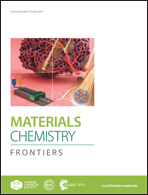Stimuli-responsive nanocarriers constructed from pillar[n]arene-based supra-amphiphiles
Abstract
Supra-amphiphiles assembled by macrocycle-based host–guest interactions have received considerable attention in recent years due to their dynamic properties and wide applications. Pillar[n]arenes are a unique family of macrocycles which exhibit outstanding host–guest behavior. Developing water-soluble pillar[n]arene (WP[n]) based supra-amphiphiles is an effective way to introduce this special macrocycle into functional nanomaterials through controlled self-assembly. Specifically, WP[n]-based supra-amphiphiles can further form different nanomaterials, such as micelles, vesicles, and other types of nanoparticles (NPs), which may become good candidates for nanocarriers of payloads. Herein, we highlight recent significant achievements in functional nanocarriers fabricated from supra-amphiphiles based on WP[n]s. By showing a series of examples, the preparation strategies, characterization, and stimuli-responsive behaviors of these nano-sized assemblies based on WP[n] derivatives are described. Furthermore, some important applications of WP[n]-based nanocarriers, such as drug/gene/protein delivery, photodynamic/photothermal therapy, and optical materials, are discussed in detail. Finally, future challenges and research directions in this rapidly evolving field are outlined.
![Graphical abstract: Stimuli-responsive nanocarriers constructed from pillar[n]arene-based supra-amphiphiles](/en/Image/Get?imageInfo.ImageType=GA&imageInfo.ImageIdentifier.ManuscriptID=C9QM00428A&imageInfo.ImageIdentifier.Year=2019)
- This article is part of the themed collections: Supra-amphiphiles and 2019 Materials Chemistry Frontiers Review-type Articles


 Please wait while we load your content...
Please wait while we load your content...